Content
1. The Dharmashastra reference for use of mud idol of Shri Ganesh Deity !
2. Making an idol from china clay or mud
2 A. Spiritual experiences of idol makers when making idols of mud or clay
3. Sculpting an idol is superior to using a mould
5. Form of the idol should be according to the science behind the idol
5 A. Idols of Shri Ganesh should not have weird forms and attires
5 B. Idol should be a seated one, not standing
5 C. Idol makers should refuse to make idols not in consonance with science
7. Necessity of observing religious restrictions when making an idol
8. Making idols considering it to be a holy mission
9. The idol should have a religious background
Anything which is in consonance with the scriptures proves to be ideal and beneficial. According to this rule, if the idol of Shri Ganesh is sculpted as per the science behind the idol then the pure spiritual particles of Shri Ganesh get attracted towards the idol to a greater extent and those worshiping it are benefited. Unfortunately today, idols are worshiped in various forms and shapes based on one’s liking and imagination without taking into account the science behind the idol. During the festival of Ganesh Chaturthi, the Ganesh idol is worshiped on a large scale both, individually and in a collective manner. The non-conformity of the idols is conspicuous at this time. It is for this reason that it is discussed in depth as to how the Ganesh idol should be sculpted for Ganesh Chaturthi, the benefits of doing so and the spiritual loss if not made in that manner.
1. The Dharmashastra reference for
use of mud idol of Shri Ganesh Deity !
As per the religious scriptures, performing the ritualistic worship of a mud idol of Shri Ganesh Deity as per Dharmashastra, gives maximum spiritual benefit.
Following rules have been mentioned in ‘Dharmasindhu’ in regards to how the idol of Shri Ganesh should be.
तत्र मृण्मयादिमूर्तौ प्राणप्रतिष्ठापूर्वकं विनायकं षोडशोपचारैः सम्पूज्य…। – धर्मसिन्धु, परिच्छेद २
Meaning : On this day (Bhadrapad Shukla Paksha Chaturthi) ritualistic worship of an idol of Shri Ganesh made from mud etc is done after doing the ‘pranpratishtha’….
Another reference is seen in the religious scripture ‘Smrutikaustubh’, where Shri Krushna asks Dharmaraja to perform the vow of Shri Siddhivinayak. In this a detailed explanation of how an idol of Shri Ganesh should be has been mentioned.
स्वशक्त्या गणनाथस्य स्वर्णरौप्यमयाकृतिम् ।
अथवा मृण्मयी कार्या वित्तशाठ्यं न कारयेत् ॥ – स्मृतिकौस्तुभ
Meaning: For this Siddhivinayak vow, a Ganesh idol can be made of Gold, Silver or Mud as per once capabilities. Do not be stingy while doing so.
A clear reference has been made here that the Ganesh idol should be made either from Gold, Silver and Mud only and no other material. Thus, Idols made from any other material are against the religious scriptures.
2. Making an idol from china clay or mud
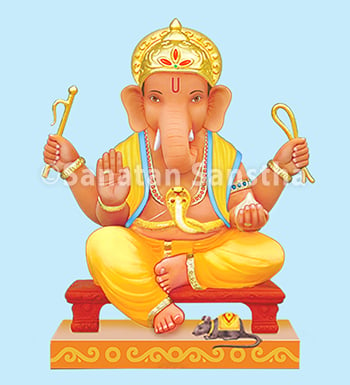
Shri Ganapati Idol |
One should prepare the Ganesh idol from china clay or mud. Nowadays, idols are made from plaster of Paris so that they become light weight and more attractive. There is a difference between idols made from mud and plaster of Paris. There are references in the Purans (mythological texts) that Ganapati was created from grime. Hence it is appropriate to use a Ganesh idol made of mud for ritualistic worship. The pure spiritual particles (pavitraks) of Ganapati get attracted to a greater extent towards an idol made of mud than to that made of plaster of Paris. The following points shall illustrate how it is improper as well as harmful to make idols from plaster of Paris or from substances other than china clay.
A) Plaster of Paris does not dissolve easily in water and hence the idol floats on water after immersion. Sometimes in cities, the remains of idols which have not dissolved in water for a long period are collected and a bulldozer is run over them to convert them into mud. This amounts to extreme denigration of the deity. The deity should be offered the same reverence when immersing it as when it is invoked. Since the idol is not immersed properly, in a way it amounts to dishonouring the deity.
B) Mixing of the plaster of Paris in water pollutes the river, sea, lake, etc. and can have an adverse effect on the health of living beings.
C) Nowadays a wrong trend has set in whereby idols are even made from coconuts, bananas, betulnut, silver, coins, etc. Some of these objects do not dissolve in water after immersion of the idol. The remains of such idols are used for other purposes or as toys by children.
2 A. Spiritual experiences of idol makers when making idols of mud or clay
Many idol makers get the spiritual experience of the God principle when making idols of mud rather than of plaster of Paris. The spiritual experience of an idol maker is given here as an example.
‘I made idols of plaster of Paris as well as clay for the Ganesh festival. I experienced immense Bliss (Anand) when making idols of mud. So also my repetition (chanting) of the Name of my family deity (kuladevata) was occurring continuously. I did not experience this when making plaster of Paris idols.’ – Mr. Lakshman Ahoman Chavhan, P.O. Dhule, Maharashtra
3. Sculpting an idol is superior to using a mould
Nowadays, idol making houses have taken the form of a vocation to earn money rather than considering it to be a holy mission or art. The Ganesh idols are made using a mould so that they can be made available for sale faster, merely keeping a commercial angle. However as far as possible, a readymade mould should not be used. The reasons for this are as follows. When making the idol manually, idol makers get an excellent opportunity to exhibit their artistic skill and consequently they obtain satisfaction. Besides, sculpting the idol generates more spiritual emotion (bhav) in the sculptor and such an idol is more sattvik (sattva predominant). From a sculptor’s viewpoint, the amount of spiritual emotion generated when sculpting the idol is more important than making the idol artistic and attractive. Hence as far as possible idol makers should make idols manually. Sanatan’s perspective too is ‘Art for God realisation and not merely art for the sake of art or as business’.
4. Idols should not be huge
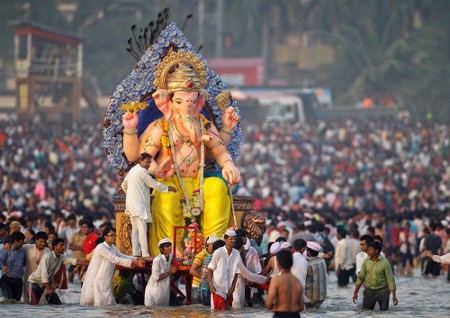 Huge Ganapati Idol
Huge Ganapati IdolSince 1980, there has been a considerable increase in the number of huge idols used in the Ganesh festival celebrations. Prior to that, the idols were made upto a maximum height of 5 feet. Nowadays idols of 11, 21, 51 feet height are made. The possible losses which can be incurred due to huge idols are given below.
A) According to the scriptures, the height of the Ganesh idol should be limited. The idol should have a maximum height of 1.5 metres because an idol larger than that makes it difficult to perform ritualistic worship. The custom of keeping a small idol for ritualistic worship and a huge idol for exhibition is absolutely incorrect. Idols of deities cannot be objects of exhibition.
B) As sufficient clay is not available to make huge idols, sometimes the idols are made from dry leaves and grass with a coating of clay over it. How much divinity will be present in such an idol ?
C) When making huge idols, iron rods, bamboos, etc. are required to be inserted within them for support. It is improper to use such objects in the idols. Besides, if these idols surface above the water source after immersion, some people even break them and sell the iron rods and wooden plates found within.
D) It is very cumbersome and expensive to transport huge idols. Traffic congestion during transportation of these idols is a common phenomenon. There is also the risk of touching electric cables when transporting idols which are 51 feet high. At times, people even get injured while loading and unloading the huge idols from trucks.
E) Since transportation of huge idols is very slow, their arrival at the site of immersion is delayed. By then if there is high tide, one cannot go deep into the sea. By rule, the huge Ganesh idols should be taken into the sea for immersion before high tide, where the water is 10 to 15 feet deep. In reality however, the huge idols are immersed in water which is merely 6 to 7 feet deep. During immersion, the idols on trolleys are thrown into the water by fastening a rope around the neck of the idol. Thus the idol cracks and breaks down into several pieces. So also, sometimes the volunteers of the festival committees are so exhausted by singing and dancing in the procession that they are not prepared to immerse the idol in deep water. They partially immerse the idol in water, place it horizontally and leave.
F) The other idols and scenes kept along with the Ganesh idol should not be huge in size. When offering obeisance, one should touch the feet of the deity by which one can derive greater benefit of the energy emitted by the deity. This is not possible in the case of huge idols. It would be worth knowing the experience of a devotee of Shri Ganesh who insisted on having a huge idol. At Colval in Goa, a devotee obstinately made an idol which was the biggest in the entire village. He had to break the door of his house to take the idol inside! The government itself should enact a law to check the production of huge idols. If those making huge idols and Ganesh festival committees are fined heavily then it will curb this practice.
5.Form of the idol should be according to the science behind the idol
The form of the idol should be such that devotion (bhakti) and spiritual emotion (bhav) towards the deity should be awakened instantly on seeing it. The Ganesh idol should be made according to the science behind the idol. The trunk of the idol should be curved towards the left.
5 A. Idols of Shri Ganesh should not have weird forms and attires
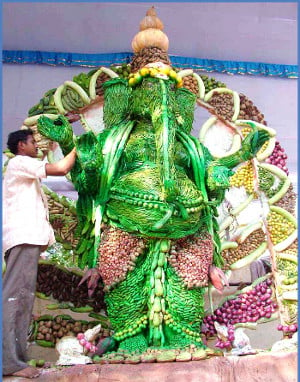
Shri Ganapati idol made from vegetables
Nowadays, the custom of making idols of Shri Ganesh in varied forms and attires has become prevalent, e.g. Shri Ganesh attired in a loin cloth, resembling Shri Krushna adorning a peacock feather on the head, resembling Shri Dattatraya, attired as a child, etc. are seen. During the period of the freedom struggle, Ganesh idols would be made in the form of Gandhiji or Nehru on public demand. Similarly, idols resembling King Shivaji Maharaj or a saint are made today also. Idols of Ganapati playing cricket or football, riding a motorcycle, etc. are also made. A Ganesh festival committee in Kalyan near Mumbai had made a Ganesh idol from medical equipment, a syringe to depict the trunk, kidney trays were used for the ears, a bottle for the crown, gloves for the hands and capsules for eyes. An unnecessary and futile effort merely to combine imagination and modern lifestyle is seen when making such idols. This is totally erroneous because Shri Ganapati cannot be compared to a leader, soldier, sportsman, etc. The Ganesh idol is humanised to gain cheap popularity and publicity. There is a difference between saints and Deities; hence idols should not be made in the form of saints too. In 1950, the Maharashtra government had imposed a ban on the variation in attires of Ganesh idols and their humanisation. However in the course of time, these rules were relaxed. Idols in varied forms and attires adversely affect the faith (shraddha) and spiritual emotion (bhav) harboured by people towards the deity. So also, depicting the deity in such different forms amounts to disrespect for the deity. According to the science of Spirituality, each deity is a specific principle. According to the doctrine that the word, touch, form, taste, fragrance and the energy associated with them coexist, only if the idol is made in accordance with the science behind the idol, is the principle of the respective deity drawn towards it. If this doctrine is not followed when making the idol then that principle is not imbibed in that idol. Consequently, the devotee does not benefit spirituallyfrom that idol from the view point of Spirituality.
5 B. Idol should be a seated one, not standing
If a guest pays a visit, we offer him a seat and not keep him standing. During Ganesh Chaturthi, we invoke Shri Ganapati, that is invite Him. One should offer Him a seat and proper hospitality. Harbouring the spiritual emotion (bhav) that Shri Ganapati has actually come to visit us. Besides due to the entire weight of the idol resting on the feet, the idol may even break if it is kept in the standing position for ten consecutive days. Hence one should make an idol which is seated on a wooden seat (pat).
5 C. Idol makers should refuse to make idols not in consonance with science
Refusal by the idol makers to make idols which are not in consonance with the science behind the idol shows their commitment to Righteousness (Dharma) and their dutifulness. If idol makers emphatically refuse to make such idols, such idols will not be made at all. It is now necessary that idol makers themselves take the initiative to eliminate the ignorance of the society and the Ganesh festival committees about the science behind the idol. They should not worry about losing customers and starvation because if we make a sacrifice for the sake of Righteousness then God will certainly take care of us. Sanatan launches a widespread campaign so that the idol makers understand the science behind the idol and make idols in accordance with it. Once this awareness is created in idol makers, it will not be long before people too realise it.
6. Colour of the idol
People have experience that an idol made with natural colour looks more appealing and imparts more Bliss (Anand) than one made with artificial red colour.
7. Necessity of observing religious restrictions when making an idol
According to the scriptures, prior to the commencement of making Ganesh idols, it is necessary to perform religious rituals such as ritualistic worship (puja), etc. It is vital that the idol maker observes all the religious restrictions in the idol making house when making the idol. The idol maker should observe restrictions such as abstaining from eating meat, not wearing foot wear, not allowing women having menses in the room where the idols are made, etc.
8. Making idols considering it to be a holy mission
The idol maker should harbour the spiritual emotion (bhav) that it is not he who is making the idol rather it is GodHimself who is getting it done through him. He should repose faith that making idols is not a vocation but a holy mission. When an idol is made with this faith and with repeatition (chanting) of God’s Name along with observance of all the restrictions given above, it becomes more sattvik (sattva predominant).
9.The idol should have a religious background
Many a time, scenes related to politics, the Kargil war, etc. are erected around the idol. Such raja-tama items erected merely for public entertainment and cheap popularity adversely affect the overall sattvik atmosphere there. If at all any scenes are to be displayed in front of or behind the idol of Shri Ganesh or other idols are to be kept there then they should be associated with Shri Ganapati. This helps to generate spiritual emotion (bhav) in the devotees.

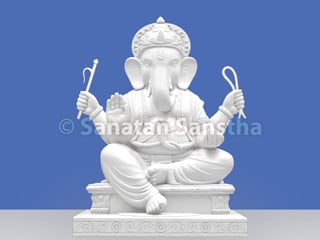 What are the incarnations of Shri Ganesh in each yug ?
What are the incarnations of Shri Ganesh in each yug ?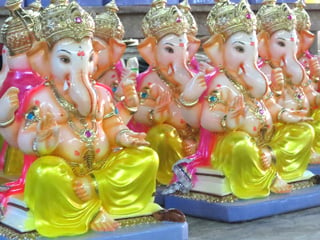 What are the different variations of Ganesh idol?
What are the different variations of Ganesh idol?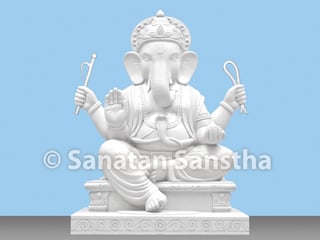 Science underlying the sculpture of Shri Ganapati
Science underlying the sculpture of Shri Ganapati